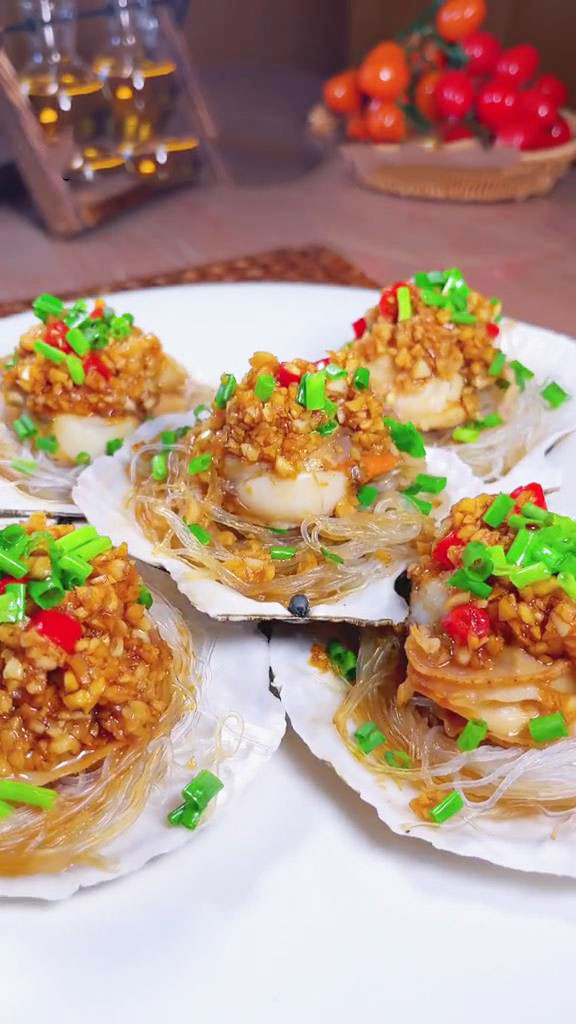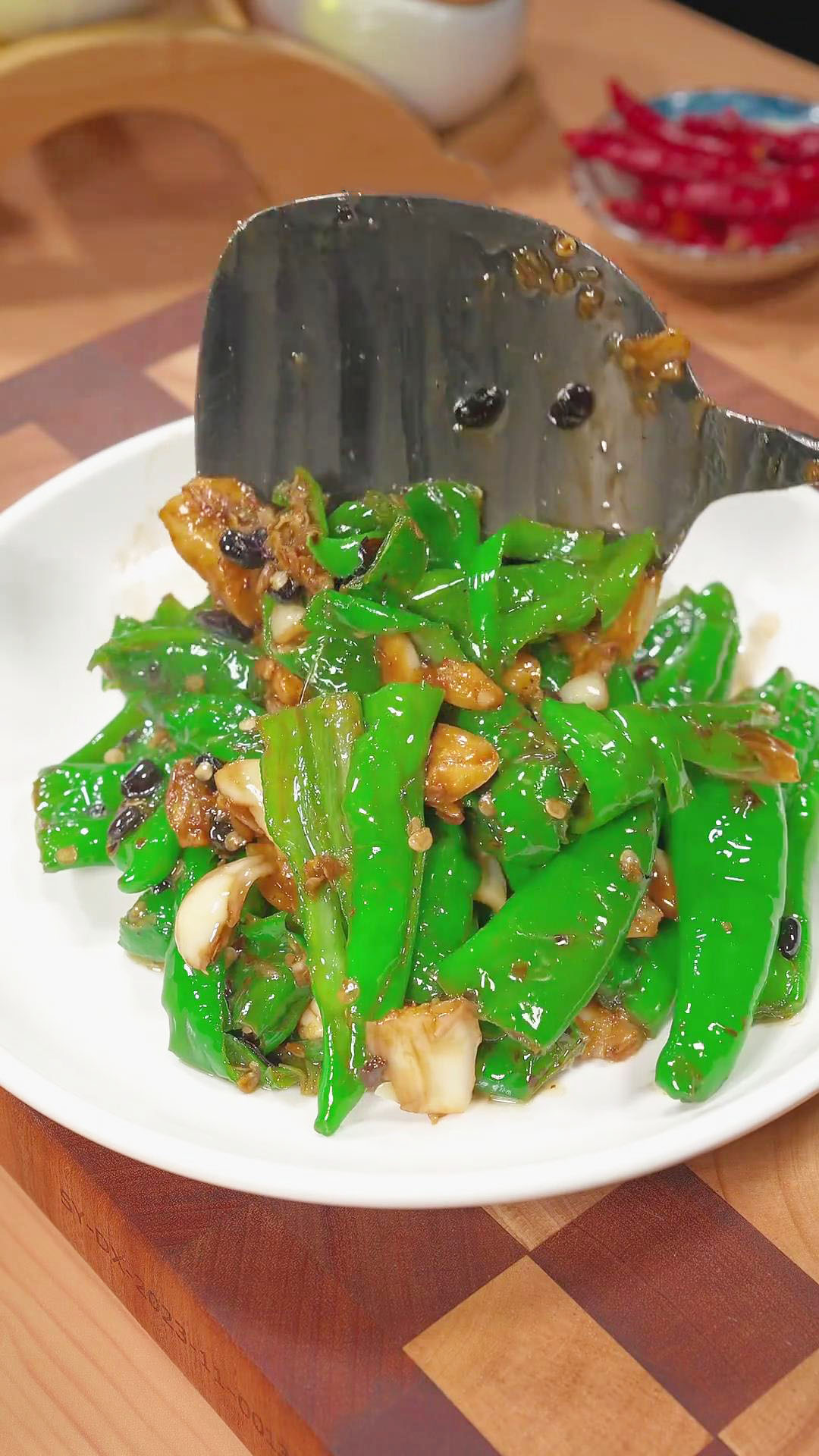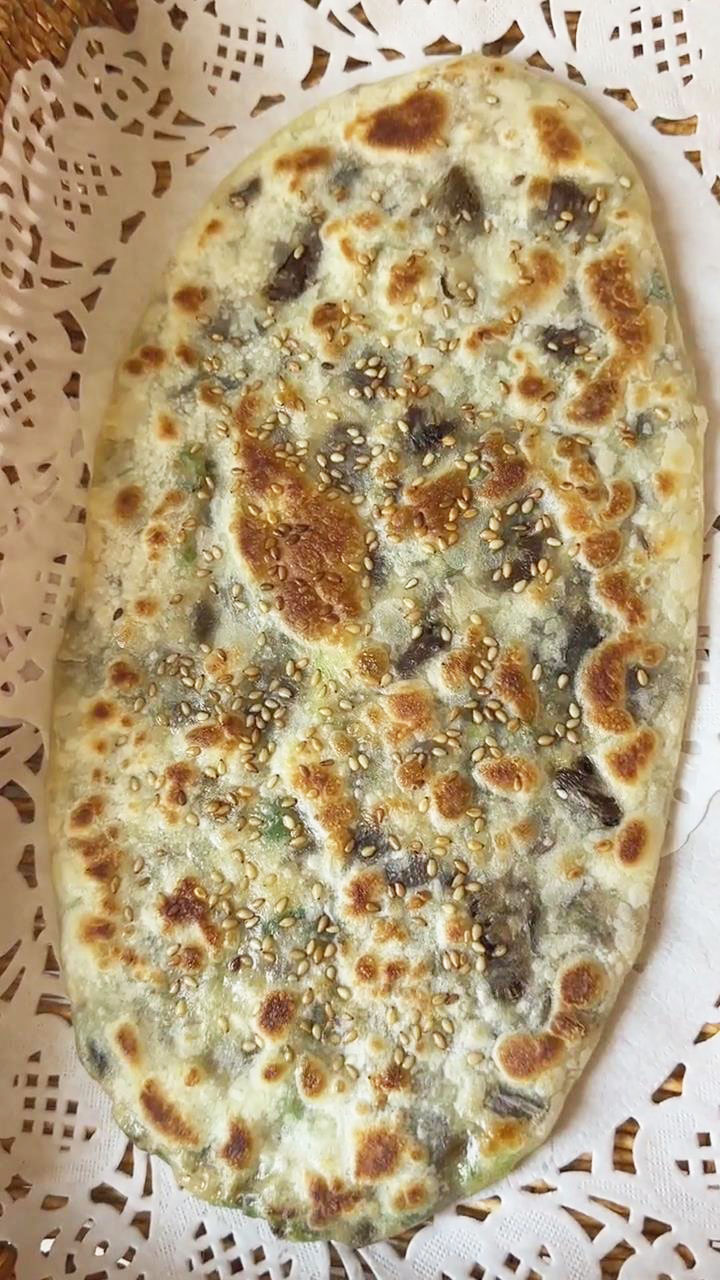This post may contain affiliate links. Please read our disclosure policy.
Bao zai fan is just like my one-pot taro rice recipe, but this time I used a clay pot to cook rice with the meaty ingredients. It gives a contrast of flavors and textures with its variety of ingredients, including Chinese sausages, Chinese cured pork belly, corn, and yu choy. Enjoy its signature crispy scorched rice base and the delightful soy sauce-based sauce.
What Is In The Clay Pot Rice Recipe?
Clay pot rice or bao zai fan is a one-pot rice recipe that uses a variety of vegetables and meat.
It typically uses Chinese sausage or marinated chicken as its main protein. The salty meats are countered with additional vegetables of your choice.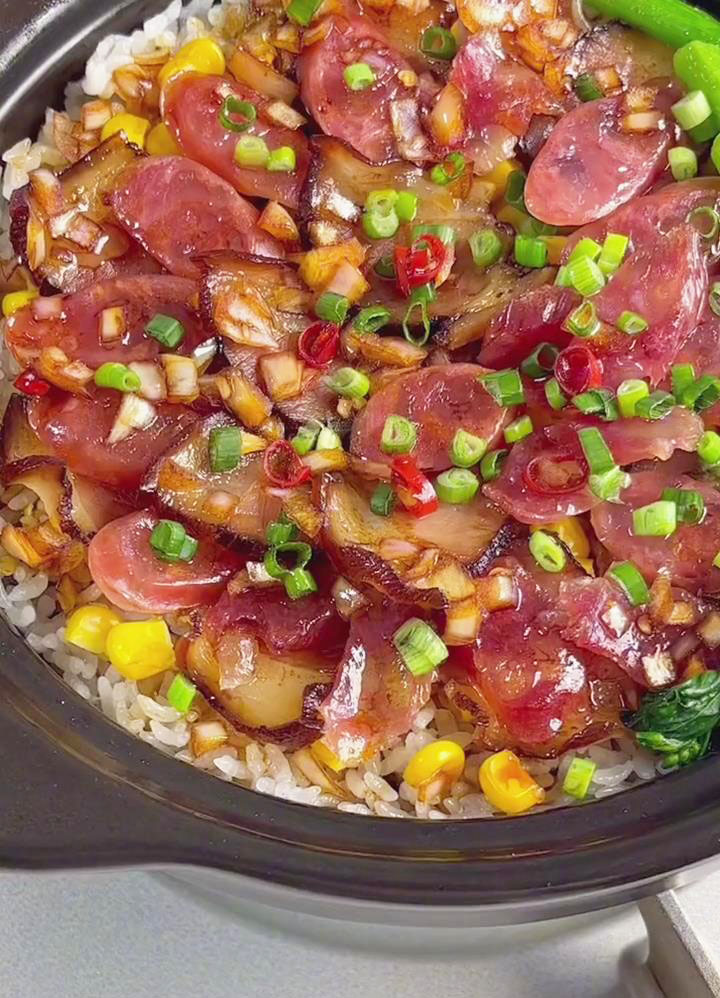
It gets its wonderful aroma and flavor from the drizzled sauce, which I made with chopped red onions, hot oil, light soy sauce, dark soy sauce, oyster sauce, sugar, salt, and chili peppers for spice.
What makes this clay pot rice special and scrumptious is its crispy scorched bottom as you enjoy the soft flavorful rice and delicious toppings. You will love the salty and umami meats, flavorful sauce, and the delightful crunch of the vegetables.
This comfort food can be done in 30 minutes or less.
Follow my 10 detailed steps below to achieve the best taste and texture. If you are planning your next rice dish, check out these rice recipes as well:
- Shrimp Congee With Leftover Rice
- Fried Sticky Rice (Stir-Fried Chinese Sticky Rice)
- Chinese Sausage Fried Rice (Lap Cheong Chow Fan)
- Lo Mai Gai Recipe (Lotus Leaf Sticky Rice Chicken)
- Traditional Chinese Egg Fried Rice (蛋炒饭)
- Yang Chow Fried Rice (Yangzhou Fried Rice 扬州炒饭)
- Shrimp Fried Rice (Din Tai Fung Style)
- One-Pot Taro Rice (Yam Rice) Recipe
Why Clay Pot Is Better Than Others
You may be tempted to use a different pot. But trust me, you don’t want to remove the clay pot from the recipe if you want to achieve the authentic clay pot rice texture. Buy one from your local Asian or Chinese store or online markets like Amazon.
There are different shapes and kinds of clay pots, but be sure to get one for Bao Zai. Avoid the ones with cracks since this can cause the juices and water to leak out of the pot.
It is important to note that different clay pots may have different instructions before use, so make sure to read them before cooking with the clay pot.
Here’s why you should have a clay pot for this type of recipe:
- The texture you are going for is soft rice with a scorched bottom. Not only the rice at the bottom of the pot are scorched but the sides as well thanks to its round shape. It is not burnt, just a delightful crispy rice crust. This scorched texture can only be achieved with a clay pot.
- Clay pots are best for retaining heat and distributing it evenly throughout the pot. Thus, the ingredients are cooked consistently and the flavors are fused nicely.
- Not only is it beneficial for heat, but it also circulates and retains moisture. Thanks to its porous surface and natural insulation features, steam is retained to prevent the ingredients from drying out. It keeps the juices of the meat and flavoring ingredients.
- After cooking the dish, you don’t need to transfer it to a serving plate anymore. You can serve the dish with a clay pot for a more authentic display on the table. Plus, letting the dish stay in the pot keeps it warm for a longer period.
- If you don’t have a clay pot, you can still continue with the recipe using a different kitchenware. You can use a non-stick pan or cast iron pot with a lid and let the rice cook until you have a crispy bottom. Using a rice cooker or instant pot can still fulfill the recipe, but the scorched bottom may not be achieved. Nevertheless, it will still be a flavorful rice dish with its meat, vegetables, and sauce.
How To Personalize This Dish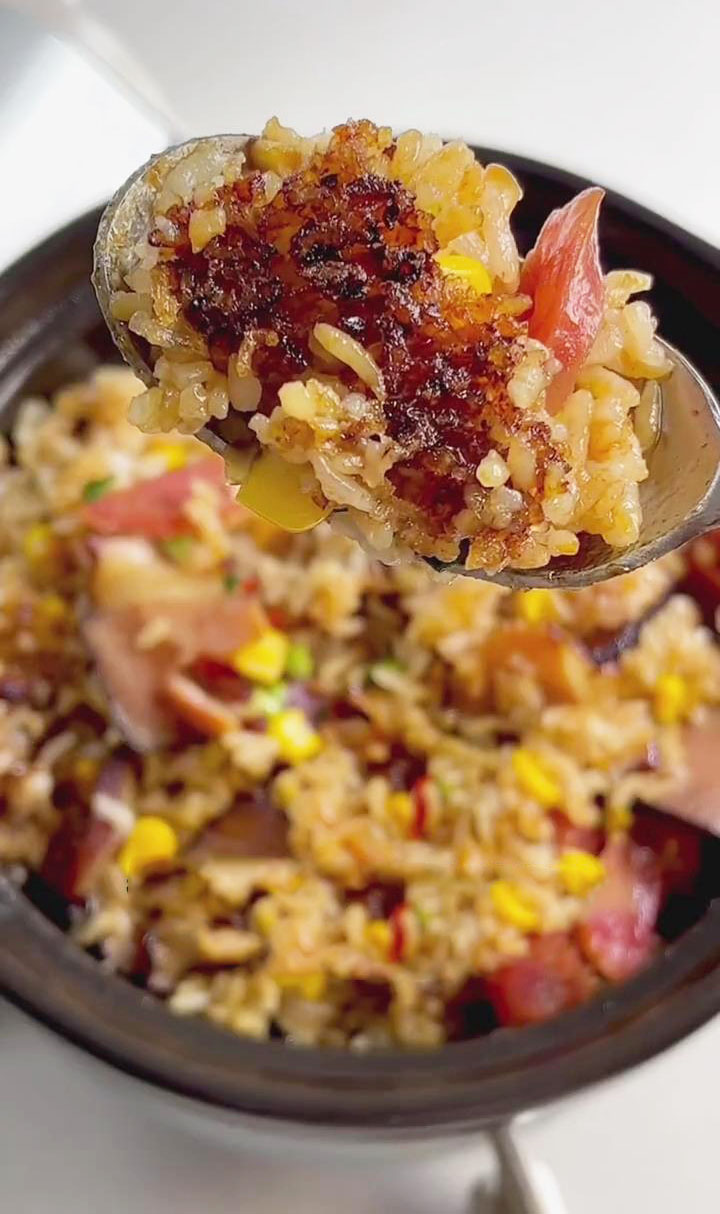
I love how flexible this dish is since you can choose your preferred ingredients.
Whether you like to use your leftovers, prefer something meaty, or want to change the seasonings, the custom options are endless.
If you need ideas on how to personalize this dish, check out my tips and recommendations below:
- Rice: You can use jasmine rice, basmati rice, japonica rice, or any medium to long-grain rice. Avoid short-grain rice like sticky rice since it will make the rice too sticky. In this recipe, soaking is no longer required. However, soaking for an hour is an extra step you can do if you want to shorten the cooking time.
- Water: I added water until it reached about 1 centimeter higher than the level of the rice. The ratio of rice to liquid should be approximately 1:1 by volume. This gives you a soft and sticky rice texture. You can reduce the amount of water if you want it to be less soft. Do not add too much water. Less water helps create the scorched rice bottom. Aside from water, you can enhance the rice taste by using unsalted stock or broth. You can also use mushroom water if you are using rehydrated dried mushrooms.
- Oil for clay pot: The oil is poured on the edges of the pot cover. This step is done after boiling and poking holes in the rice. Any cooking oil will do for this recipe. Use olive, avocado, sesame, or safflower oil for a healthier option. If you want a neutral taste, go for peanut, soybean, or vegetable oil. Adding oil helps create the dish’s signature scorched bottom.
- Chinese sausage: Chinese sausage is also called lap cheong. It adds a sweet and savory taste to the rice. This is typically bought in Asian or Chinese grocery stores or online markets like Amazon. I used two sausages and placed them on top of the rice. If you have extra time, you can make this yourself using my Homemade Chinese Sausage This recipe requires only 5 ingredients: pork shoulder and fat, sugar, salt, baijiu 白酒. As a last resort, you can use other types of sausages, such as salami, pepperoni, bacon, or regular sausage.
- Chinese cured pork belly: Chinese cured pork belly is also referred to as Chinese bacon. This is also widely available in Asian grocery stores labeled as Chinese bacon, là ròu, and lap yuk. It is an excellent ingredient for the rice that adds salty and umami flavors. Aside from store-bought Chinese cured pork belly, you can opt for a homemade version instead with my Chinese cured pork belly The steps involve marinating, hanging, and drying the meat. The next best alternatives to Chinese cured pork belly are other types of pork belly recipes, such as crispy pork belly, roast pork belly, or pork belly char siew.
- Optional meat varieties: Aside from Chinese sausage and pork belly, here are other meat ingredients to choose from:
- Chinese dried cured ham
- Chinese-style roast pork
- Pork ribs
- Char siu pork
- Ham and BBQ meats
- Luncheon meat or Spam
- Scrambled eggs
- Marinated chicken or duck meat
- Shrimp
- Vegetables: To counter the salty taste of the meat, I added corn and yu choy. Basically, you can add as many vegetables or non-meat ingredients as you want. You can pack it with just vegetables if you prefer an all-veggie version for a healthier alternative. Here are my suggestions on vegetables and non-meat ingredients to include:
- Bok choy
- Dried shiitake mushrooms (Rehydrate it first and season it)
- Fresh mushrooms (shiitake, button, or oyster)
- Fried tofu cubes
- Bamboo shoots
- Bell peppers
- Scallions or green onions
- Finely chopped cabbage
- Diced carrots
- Sauce: After cooking the rice with the sliced meat and vegetables, this savory sauce is poured on top and mixed throughout the rice and toppings. My sauce recipe includes diced red onions, hot oil, dark soy sauce, light soy sauce, oyster sauce, salt, sugar, and red chili peppers (optional for spice).
- Diced red onion: It is best to dice the red onions so they easily spread throughout the rice. Any kind of onion will work well with the recipe with little significant difference in taste. You can also use white onions, yellow onions, shallots, and green onions.
- Hot oil: Hot oil is essential in partially cooking the sauce ingredients and fusing the flavors harmoniously. I recommend oils with a high smoke point to reduce the amount of oil oxidized and to withstand heat longer, such as avocado, peanut, canola, and corn oil. You can also opt for oils with a neutral taste like peanut, soybean, or vegetable oil. For a healthier alternative, use olive, avocado, sesame, or safflower oil.
- Dark and light soy sauce: I used this combination to add deep color and slight sweetness using dark soy sauce and a salty, umami taste with the light soy sauce. Adjust the amount according to taste. You can substitute dark soy sauce with other types of thick sauces, like double black soy sauce, oyster sauce, and teriyaki sauce. For the light soy sauce, you can swap it with tamari, liquid aminos, coconut aminos, or gluten-free soy sauce.
- Oyster sauce: Add oyster sauce to impart a savory, caramel-like taste, similar to barbecue sauce and soy sauce. You can replace oyster sauce with hoisin sauce, teriyaki sauce, kecap manis, Worcestershire sauce with soy sauce and sugar, oyster-flavored sauce, or fish sauce.
- Salt: Salt brings out the flavors and aroma of the sauce ingredients. You can use pink salt, table salt, kosher salt, or sea salt.
- Sugar: Sugar will balance out the flavors and make it less salty. You can use white sugar, cane sugar, brown sugar, maple syrup, or coconut sugar.
- Red chili peppers: If you want to make it hot and spicy, add chopped red or green chili peppers. If you don’t have chili peppers, substitute 1 whole chili pepper with 1/4 tsp chili flakes. You can omit this from the sauce if you are not a fan of spicy food.
- Optional seasonings: Here are some seasonings to consider to further enhance the sauce:
- Chinese five-spice powder
- White or black pepper powder
- Shaoxing wine
- Sesame oil
- Chicken or vegetable bouillon powder
- Green onion: I used chopped green onions or spring onions for my garnish. Green onions are great for color and a slight sweetness. If you don’t have green onions, you can substitute this ingredient with chives, shallots, or regular onions.
Ingredients And Kitchenware To Prepare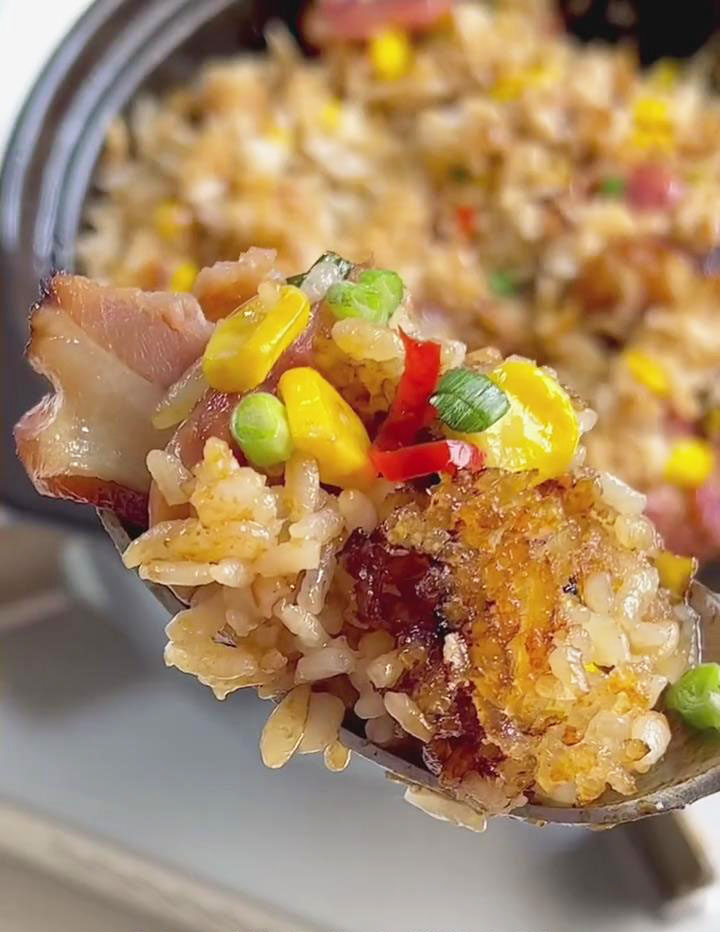
It helps to have an oil brush to rub the oil all over the pot before placing the rice. If you are not going to use a clay pot, make sure the pot you plan to use has a cover. Other things to prepare are a heat-resistant bowl for the sauce and a knife for chopping the meat and vegetables.
Here are the ingredients to prepare:
- 1 cup of rice (or more if desired)
- Oil (for brushing the pot)
- Water (about 1 cm higher than the rice level), the ratio of rice to liquid should be approximately 1:1 by volume.
- 2 pieces of Chinese sausages
- 1 piece of Chinese cured pork belly
- A drizzle of oil (for pouring on the clay pot cover)
- 2 tbsp of corn kernels
- 2 stalks of Yu choy or your choice of vegetables
- Sauce
- 10g of chopped red onions
- 1 tbsp of hot oil
- 2 tbsp of light soy sauce
- 1 tbsp of dark soy sauce
- 1 tbsp of oyster sauce
- 1/2 tbsp of sugar
- Salt (to taste)
- Red chili peppers (optional for spice)
- Chopped green onions (for garnish)
10 Steps To Make Clay Pot Rice
It may be 10 steps but it’s really more on preparing the ingredients and letting them cook together in the pot. Once the sauce is made and the ingredients chopped, the rest of the recipe steps will be a breeze. Watch my quick tutorial video on Instagram or TikTok to learn more.
- Clean the rice with water to remove the excess starch. No need to soak the rice. Drain the water right away after cleaning.
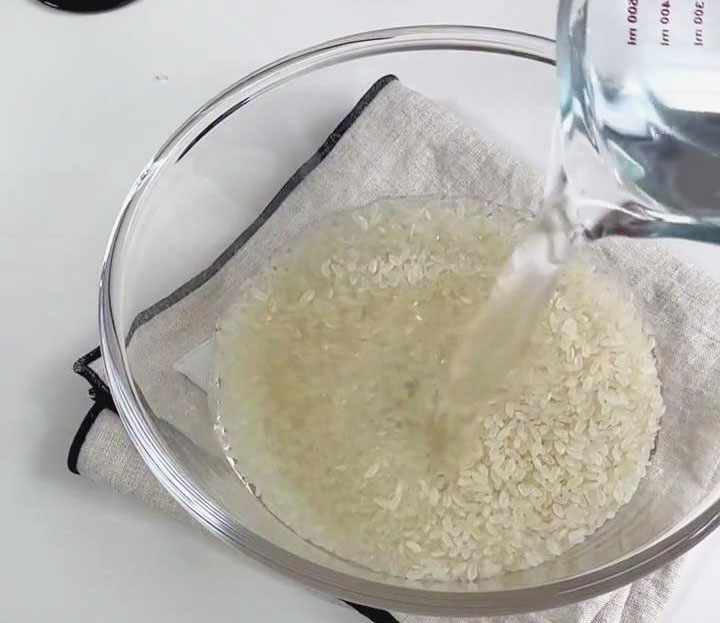
- Heat the clay pot with oil. Use an oil brush to spread the oil throughout the pot.
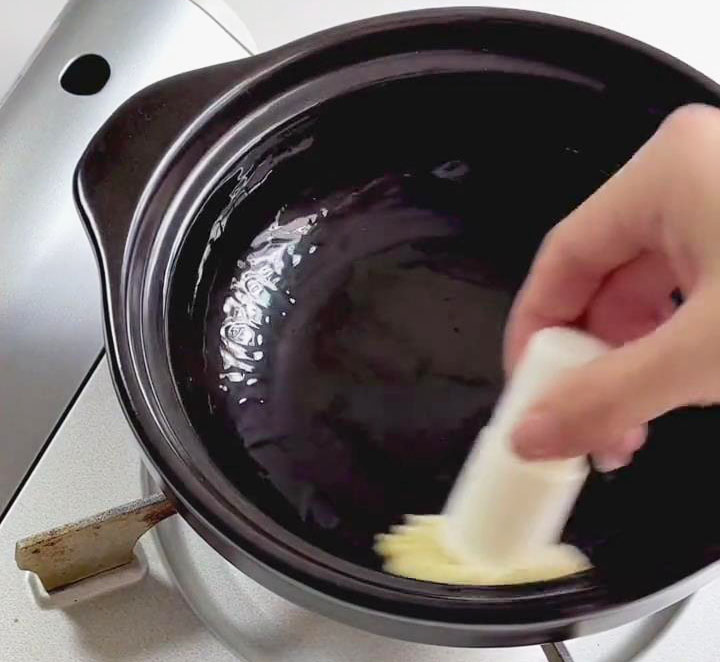
- Add the cleaned rice and flatten it. Pour water at about 1cm higher than the rice level. The ratio of rice to liquid should be approximately 1:1 by volume.
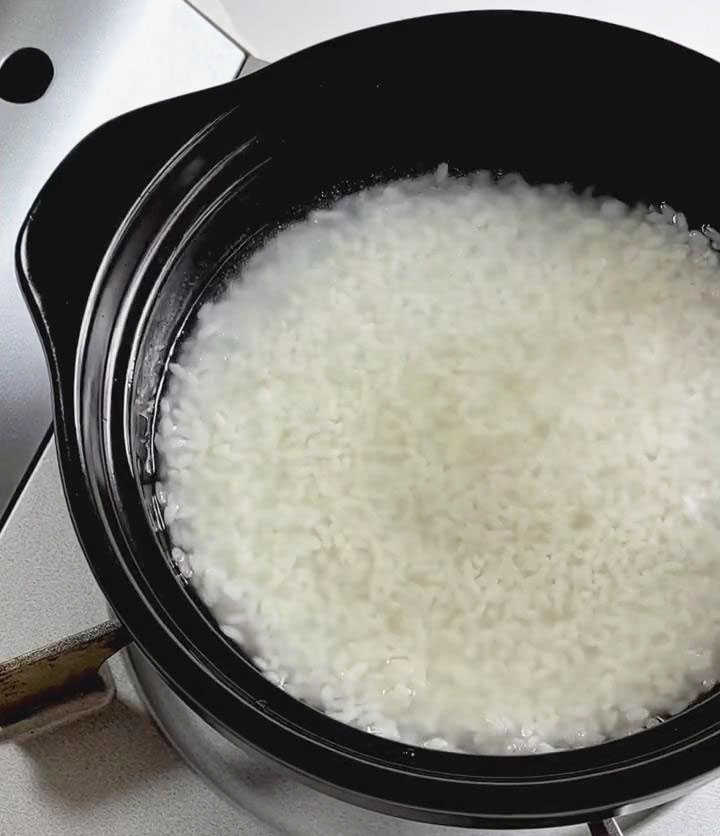
- Add the Chinese sausage and Chinese cured pork belly on top of the rice.
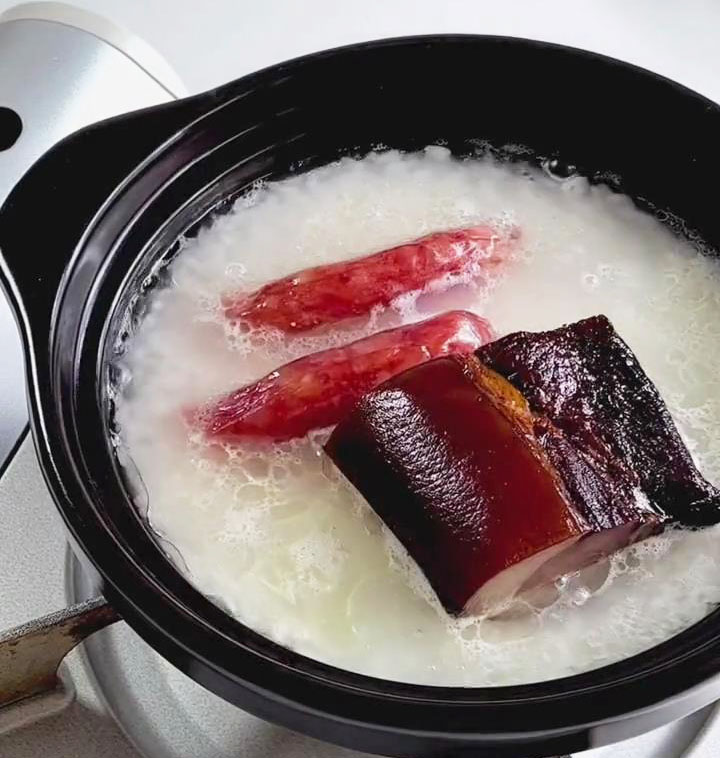
- Bring to a boil, then cover with a lid and cook over medium heat for 5 minutes. Cooking time may vary, depending on the clay pot and the amount of rice you use. Cooking on medium heat is best to achieve a scorched bottom.
- Once it starts smoking, open the pot and poke a few holes in the rice using chopsticks.
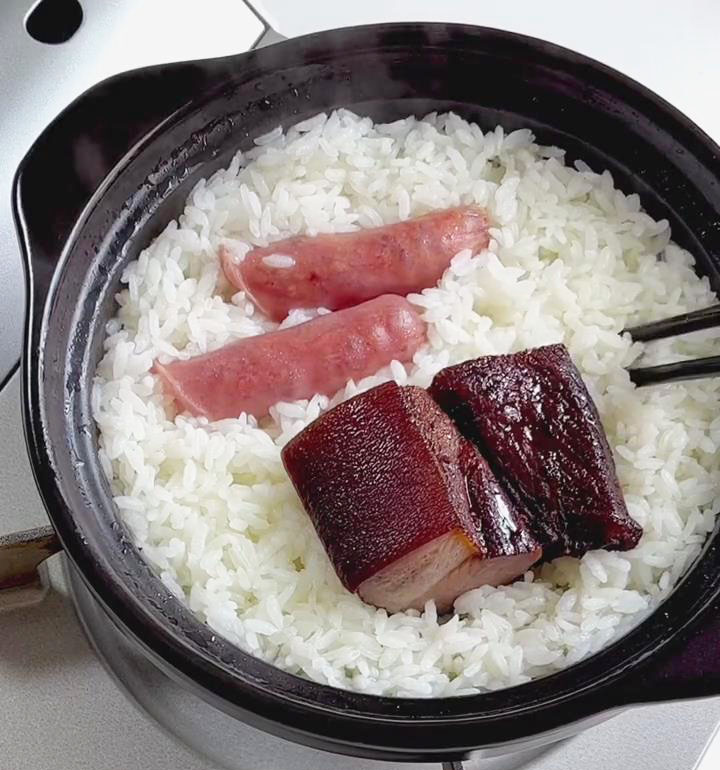
- Cover the pot again and drizzle oil around the lid’s edges. Swirl and tilt the clay pot at various positions to evenly heat it. Do this for another 2 minutes. If the oil does not sip into the pot, you may need to open the lid slightly to let the oil drip inside the pot. Remember, avoid opening the lid too frequently since you want to achieve a crunchy bottom layer.
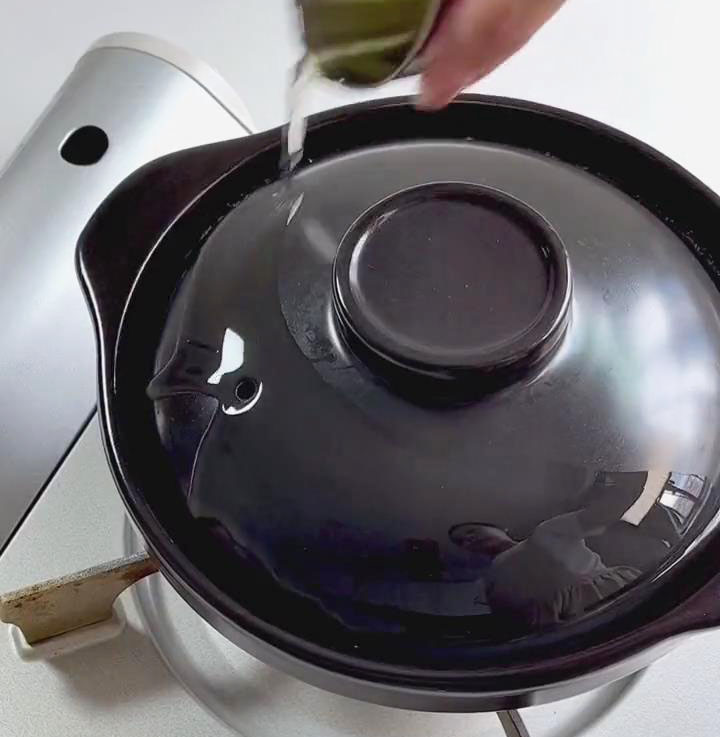
- Take out the Chinese sausage and Chinese cured pork belly and chop them into thin round slices. Add the boiled corn kernels, chopped Chinese sausage, chopped Chinese cured pork belly, and blanched yu choy. Cover the pot and continue cooking for 1 minute. If you detect a burnt aroma already, it is best to remove it from heat to prevent overcooking or burning the bottom of the rice. The aroma you want should be nutty and toasty.
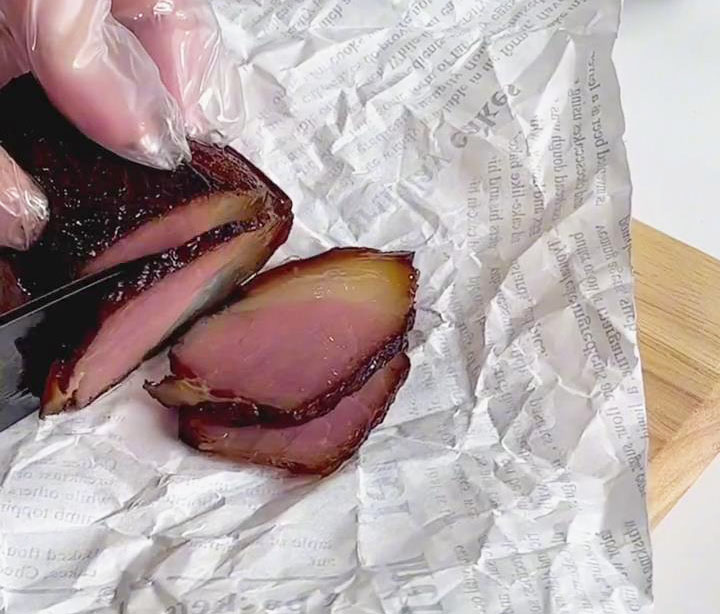

- Prepare the sauce. Mix chopped red onions, hot oil, light soy sauce, dark soy sauce, oyster sauce, sugar, salt, and chopped red chili peppers (optional for spice). Pour the sauce over the cooked rice.


- Sprinkle chopped green onions on top. Mix the rice well to evenly spread the sauce and toppings. By this time, you should be able to scoop out the scorched bottom.
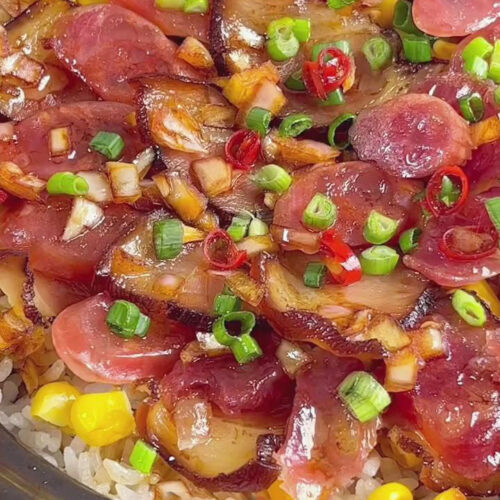
Clay Pot Rice Recipe (Bao Zai Fan)
Ingredients
- 1 cup rice or more if desired
- Oil for brushing the pot
- Water about 1 cm higher than the rice level, the ratio of rice to liquid should be approximately 1:1 by volume.
- 2 pieces Chinese sausages
- 1 piece Chinese cured pork belly
- A drizzle of oil for pouring on the clay pot cover
- 2 tbsp corn kernels
- 2 stalks of Yu choy or your choice of vegetables
- Chopped green onions for garnish
Sauce
- 10 g chopped red onions
- 1 tbsp hot oil
- 2 tbsp light soy sauce
- 1 tbsp dark soy sauce
- 1 tbsp oyster sauce
- 1/2 tbsp sugar
- Salt to taste
- Red chili peppers optional for spice
Instructions
- Clean the rice with water to remove the excess starch. No need to soak the rice. Drain the water right away after cleaning.
- Heat the clay pot with oil. Use an oil brush to spread the oil throughout the pot.
- Add the cleaned rice and flatten it. Pour water at about 1cm higher than the rice level. The ratio of rice to liquid should be approximately 1:1 by volume.
- Add the Chinese sausage and Chinese cured pork belly on top of the rice.
- Bring to a boil, then cover with a lid and cook over medium heat for 5 minutes. Cooking time may vary, depending on the clay pot and the amount of rice you use. Cooking on medium heat is best to achieve a scorched bottom.
- Once it starts smoking, open the pot and poke a few holes in the rice using chopsticks.
- Cover the pot again and drizzle oil around the lid's edges. Swirl and tilt the clay pot at various positions to evenly heat it. Do this for another 2 minutes. If the oil does not sip into the pot, you may need to open the lid slightly to let the oil drip inside the pot. Remember, avoid opening the lid too frequently since you want to achieve a crunchy bottom layer.
- Take out the Chinese sausage and Chinese cured pork belly and chop them into thin round slices. Add the boiled corn kernels, chopped Chinese sausage, chopped Chinese cured pork belly, and blanched yu choy. Cover the pot and continue cooking for 1 minute. If you detect a burnt aroma already, it is best to remove it from heat to prevent overcooking or burning the bottom of the rice. The aroma you want should be nutty and toasty.
- Prepare the sauce. Mix chopped red onions, hot oil, light soy sauce, dark soy sauce, oyster sauce, sugar, salt, and chopped red chili peppers (optional for spice). Pour the sauce over the cooked rice.
- Sprinkle chopped green onions on top. Mix the rice well to evenly spread the sauce and toppings. By this time, you should be able to scoop out the scorched bottom.

